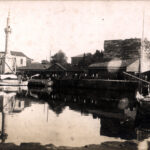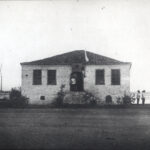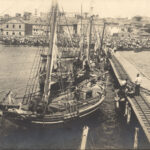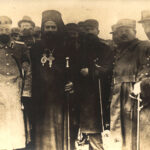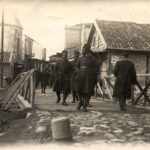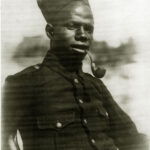History of the French military base, memorials and monuments of the First World War in the Allied Dardanelles operation. Based on our own Archives and collection in Paris.
Brief history. The Dardanelles Strait and Gallipoli Peninsula were the site of one of the major battles of the First World War, a naval battle and the largest amphibious operation. Many books have been written about the battle at Gallipoli and even a great film with the same name has been made. From a historical and tourist point of view, we divide this area into the following zones:
– Lemnos Island – military base of France and allies (Greece), 1914-1923
– The Dardanelles Strait and the city of Canakkale (Türkiye), 1915
– Kumkalle, the Asian coast and the battlefields of the French and Russian armies, 1915
– Gallipoli, peninsula, site of ANZAC and Jewish Legion battles 1915
– Gallipoli city, French military base 1919-1923
Gallipoli, now the Turkish city of Gelibolu, is a unique tourist destination associated with the history of Turkey, Greece, France, Russia, Ukraine and even Armenia and Israel. Located on European territory, the city has long been the subject of territorial disputes between Orthodox Christian Greece and Muslim Turkey. At the beginning of the 20th century, as a result of the Balkan Wars and then the First World War, the city passed from the Ottoman Empire to Greece and back. The First World War officially ended in 1919 with the victory of the Allies and the defeat of the Ottoman Empire. The Sultan signed the surrender, but the commander of the Turkish army, Ataturk, who had gone deep into the rear to the Asian coast, did not recognize the surrender and continued to fight against the Allied troops. Formally, after 1919 the war was between Atatürk’s Army against the Greek Armed Forces and lasted until 1923. We hope that one day the Les Invalides in Paris or the Museum of the First World War in Meaux will hold a special exhibition dedicated to these events of 1918-1923. Our team is celebrating the centenary of these events with our own online exhibition and virtual tour of Gallipoli and Constantinople, based on our own archives and artefacts. Over time, our collection will move to these two museums, as it was before.
Gallipoli city travel guide and virtual tour
The city has an old interesting history associated with the Ottoman Empire, numerous monuments and Muslim cemeteries, which we show below in the photo gallery. The city is multi-denominational; many Greeks, Armenians and Jews also lived here. During numerous Russian-Turkish wars, the city was located deep in the rear. According to legend, captive Zaporozhye Cossacks* were kept in the local prison and were buried in the local Armenian Orthodox cemetery. The Genoese tower with the Turkish prison (zindan) is now a local history museum and is accessible to tourists.
During the Crimean War of 1853-1856, the coalition of the Ottoman Empire, France and Great Britain against Russia, Gallipoli had medical facilities and hospitals for wounded soldiers. After this period of history, the city preserved memorials and cemeteries for soldiers of France, Great Britain and, of course, Turkish soldiers. It is possible that Russian prisoners of war were also held here and were also buried in the Armenian or Greek Orthodox cemeteries.
During World War I, the Turkish army had German military advisers who were also at Gallipoli. The city was heavily damaged by gunfire from British and French cruisers and bombs from Allied airplanes. After the Sultan’s surrender in 1919, the city became Greek and was garrisoned by the French occupation corps. The French troops numbered more than 500, mostly black soldiers from colonial Senegal with white officers and commandant. Initially, it was planned to locate it in the Buk-Dere valley, 6 kilometers from the city to the west towards Chanak-Kale, but then this idea was abandoned. Wild roses and wild roses grew in the river valley, making the area impassable. There were many snakes whose bites were fatal. As a result, the headquarters of the French army occupied houses in the city center, and the garrison was located in special barracks 1 kilometer to the east, on the shores of the bay and the sea. These barracks are now preserved, but they are occupied by the Turkish army and visiting is impossible. The headquarters of the French troops occupied the best hotel in the city center and is now even available for the accommodation.
During this period, the restoration of destroyed houses and the improvement of life in the city were actively carried out. A special place is occupied by the arrival of a huge number of Russian troops and refugees. At the end of the civil war in Russia, during the evacuation from Crimea, France took patronage over the entire Russian army and refugees. The world had never known such a mass exodus of several million people and the Allies were not prepared for such a number. The Allies provided camps for living in the Istanbul area and began to look for other places in different cities and countries. More than 25,000 people arrived in Gallipoli in November 1920, the 1st Army Corps of the Russian Army under General Wrangel. The Russian army surrendered heavy weapons and part of the light infantry to the allies during the raid in Istanbul, but one tenth remained. In Gallipoli, units of the Russian 1st Army Corps had rifles, pistols and a small number of machine guns. The city became practically Russian with its own headquarters, commandant’s office and even military prisons. The Russians occupied all the free houses in the city, the remaining units were placed in the valley of the Buk-Dere River, which the French abandoned. One Russian military school occupied barracks next to the French garrison on the shore of the strait. The Russians behaved like a real army, not wanting to become refugees. This caused great conflicts, sometimes reaching almost an armed conflict with the French garrison. Supplies and food were from France, with some help from the American Red Cross under the leadership of Major Davis. Russians have made a great contribution to the culture and traditions of the city of Gelibolu. Six theaters were opened in the small town with the participation of former famous artists from Moscow and St. Petersburg. Art exhibitions, paintings, creativity, and decorative arts were held. Russian restaurants have opened with national Russian cuisine and vodka. A fashion has emerged for evening walks along the embankment and promenade. The gulf beach was opened and sports competitions in swimming and jumping were organized. International competitions in gymnastics, football and other sports were held. The car park was about 14 units (Peugeot, Renault, Ford**..), which was a lot for a small provincial town. The cars had little gas and were used for camp trips for important guests from Paris and Istanbul. The rest of the time the cars were used for training. A few years later, many officers moved to Paris and founded the Union of Russian Taxi Drivers. Russian military engineers bought a lens at a flea market in Istanbul and made a homemade camera. Using this camera, about a thousand photographs were taken of the city, nature, houses, the life of the local population, as well as all the parades and holidays. In fact, the entire photo chronicle of Gallipoli in the early 20th century was made by Russian war photographers. Most of the photographs and glass negatives were taken to Paris a few years later and are in our possession; we publish them below. Some will also eventually be given to the Invalides or the WWI Museum in Meaux.
For the period 1920-1923, a chronology and description of events were compiled, which we also briefly post below. I would also like to say that in Gelibolu there is an excellent military Museum dedicated to the Dardanelles operation of the Allies in the First World War, as well as the presence of the French and Russian armies in these places in 1920-23.
- City center, harbor, mosque and Genoese tower, H1
- Commandant’s Office, now a military museum of the Turkish Army
- View of the city from the pier, boats
- Commander of the 1st Army Corps General Kutepov, Greek Metropolitan and French officers
- Russian sentry and French soldiers from Senegal
- Senegalese soldier, nicknamed “Serge”
** You can see the same, and perhaps even these very cars, in the excellent Automobile Museum in Reims, Champagne, France.

